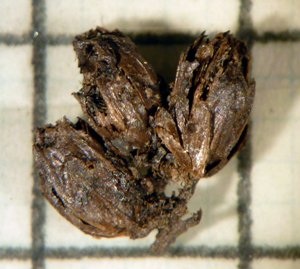
 Dec. 21, 2009 – Archaeologists from the Universities of
Dec. 21, 2009 – Archaeologists from the Universities of
Glasgow and Aberdeen have found proof that pre-historic people laid flowers at
the graves of their dead.
Dec. 21, 2009 – Archaeologists from the Universities of
Glasgow and Aberdeen have found proof that pre-historic people laid flowers at
the graves of their dead.
Experts believe the discovery of a bunch of meadowsweet
blossoms in a Bronze Age grave in Forteviot, Perthshire, is the first recorded
example of such a ceremony.

|
| Heads of meadowsweet flowers found in a Bronze Age grave in Forteviot. UNIVERSITY OF GLASGOW PHOTO |
Dr. Kenneth Brophy, of the Department of Archaeology at the
University of Glasgow, said: “The flowers are just three or four millimetres
across but they are the first proof that people in the Bronze Age were actually
placing flowers in with burials." The heads of the meadowsweet flowers
found in the Bronze Age grave in Forteviot.
It is thought the flowers were placed by the head of a
high-status individual buried within the grave, as a bronze dagger with a gold
hilt was also found in the same grave.
Dr. Brophy added: “In burials we are used to finding
metalwork, but to find these very human touches is something very rare, if not
unique. It brings it home to you that what you’re looking at is not just a
series of abstract remains, but actually these are people that you’re dealing
with.”
The gravesite had been marked by an avenue of oak posts and
earthworks.
More excavations are planned at the site, which is part of
the Strathearn Environs and Royal Forteviot Project (Serf), including efforts
to ascertain whether a sandstone slab found near the grave was part of a stone
circle.
Forteviot was the seat of power of the early Scottish kings
and was where Kenneth mac Alpin, one of the first kings of a united Scotland,
died in 858.
As one of the major early royal centres of this time period,
Forteviot plays a crucial role in assessing the complex processes that gave
birth to an early medieval nation. In addition, the fields around the village
preserve one of the most extensive prehistoric ceremonial landscapes in
Britain.
Print this page